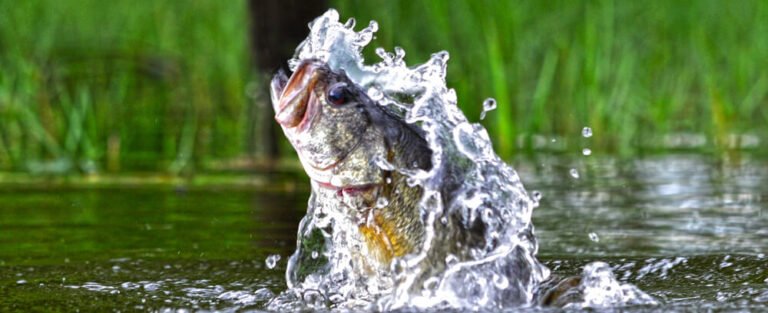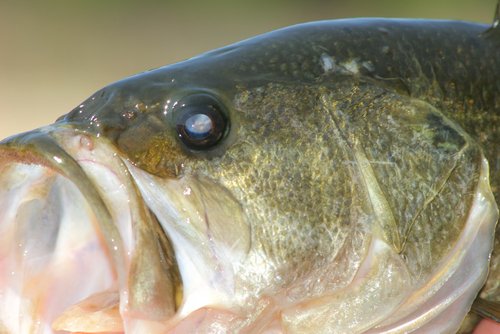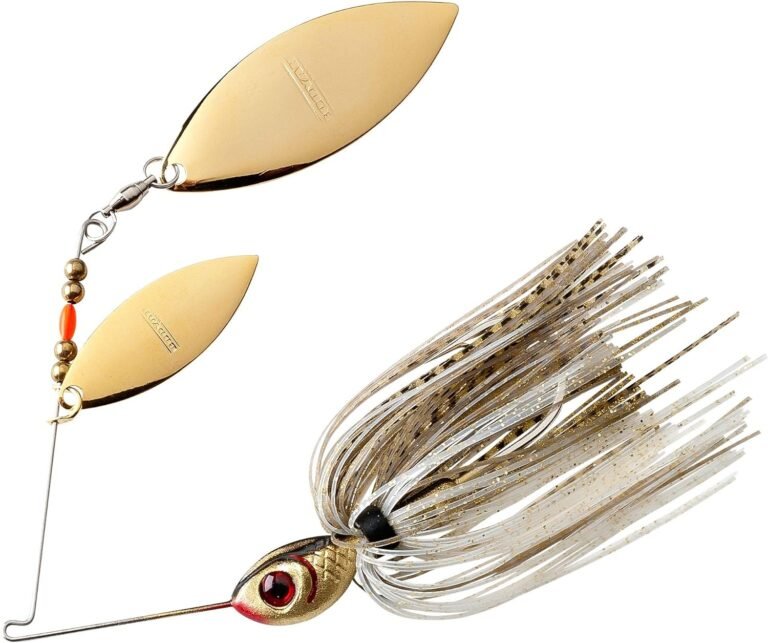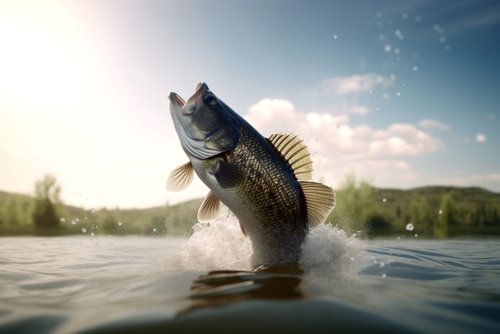Bass fishing Colorado anglers have two bass species: the largemouth and the smallmouth. These mighty fish are the stars of many fishing expeditions. While both species belong to the same family, they possess distinct characteristics that set them apart.
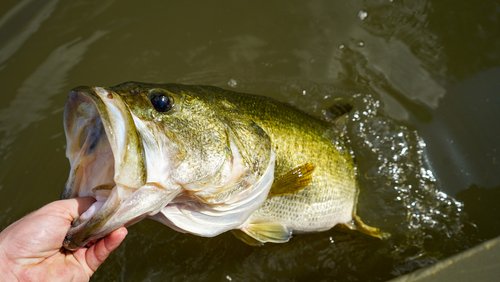
The largemouth bass, affectionately called “bucketmouths,” dominate many Colorado waters. Recognizable by their robust build and impressive size, these fish can grow up to 20 inches or more.
Their olive-green coloration is accompanied by a distinguishing dark lateral line that extends from head to tail. Largemouths are known for their impressive gape, revealing a mouth large enough to make you gasp!
Smallmouth Bass Fishing Colorado: Feisty Fighters
The smallmouth bass might not match its larger cousin in size but certainly compensates with its spirited resilience and fighting prowess. Renowned as “bronzebacks” for their unique coloration, smallmouths boast an enchanting bronze hue on their backs that transitions into pale yellow or white bellies. Their sleek body frames and vertical black stripes create an elegant appearance that delights both eyes and fishing rods.
Habitat Preferences: Where do they call home?
Colorado’s bass species share some preferences when it comes to habitat selection. Both largemouth and smallmouth bass thrive in lakes, reservoirs, ponds, and even slow-moving rivers with adequate cover such as submerged vegetation, fallen trees, rocky outcrops, or artificial structures like docks and brush piles.
Behavior Patterns: Unraveling the Mysteries
Understanding the behavior patterns of bass is crucial for successful angling. Largemouth bass are sluggish and prefer calm, warmer waters with abundant vegetation. They often lurk in ambush, waiting patiently for prey to pass by before launching a targeted strike.
In contrast, smallmouth bass are more active and favor cooler, clearer waters with rocky bottoms and swift currents. They relentlessly chase after their prey, putting up quite a fight when hooked.
Mastering the Bass Symphony
By comprehending Colorado’s bass species’ characteristics, habitat preferences, and behavior patterns, anglers can unlock the secrets that lead to successful fishing endeavors. With this knowledge, you’ll be prepared to target these remarkable fish in their natural habitats and experience the thrill of battling a largemouth or smallmouth bass on your line!
Best Bass Fishing Locations in Colorado
Highlighting Popular Reservoirs and Lakes
Colorado, with its diverse landscape, offers bass anglers various fishing destinations. Two popular reservoirs and lakes known for their excellent bass fishing opportunities stand out: Cherry Creek Reservoir and Pueblo Reservoir. At Cherry Creek Reservoir, located just southeast of Denver, anglers can find an abundance of largemouth and smallmouth bass.
The reservoir covers over 850 acres, providing ample space for anglers to explore its waters. With its clear waters and submerged structures such as rock piles and fallen trees, Cherry Creek offers an ideal habitat for bass to thrive.
Anglers often successfully use crankbaits along the rocky shorelines or plastic worms near submerged vegetation. Pueblo Reservoir is another hotspot for bass fishing in Colorado.
Located southwest of Pueblo, this sprawling reservoir spans more than 4,600 acres and is known for its trophy-sized smallmouth bass. The rocky shoreline and submerged boulders provide excellent cover where these feisty fighters hide.
Topwater lures like buzz baits or poppers can be productive during low-light conditions or early mornings. Additionally, dragging jigs along drop-offs near points can entice a strike from the resident smallies.
Exploring Lesser-Known Hidden Gems
While Cherry Creek Reservoir and Pueblo Reservoir attract many anglers seeking bass action in Colorado, there are some lesser-known hidden gems that avid bass fishermen should not overlook. One such gem is Twin Lakes near Leadville in central Colorado.
Twin Lakes consists of two interconnected lakes surrounded by stunning mountain scenery. Largemouth bass can be found in the summer months amongst the abundant aquatic vegetation lining the shorelines.
Using soft plastic baits like Senkos or creature baits rigged weedless is often productive in enticing strikes from this bass. Another hidden gem is Stagecoach Reservoir, located near Steamboat Springs.
This reservoir covers approximately 800 acres and offers fantastic bass fishing opportunities. With its diverse structure, including submerged timber and rocky points, Stagecoach provides a variety of habitats for bass to inhabit.
Anglers can succeed using spinnerbaits or plastic crawfish imitations along the rocky shorelines or drop-offs. Remember that smaller local lakes and ponds can also hold excellent bass populations while pursuing hidden gems.
These often-overlooked waters can provide a more secluded fishing experience with less angling pressure. Exploring maps, talking to local bait shops, and doing some online research can unveil secret spots where you might discover your private bass honey hole in Colorado’s vast fishing landscape.
With these popular reservoirs and lesser-known hidden gems, Colorado offers a rich tapestry of bass fishing locations for anglers to explore. Whether you seek the thrill of a trophy-sized catch or enjoy the serenity of nature while casting your line, there’s no shortage of opportunities to satisfy your passion for bass fishing in Colorado.
Techniques and Tackle for Bass Fishing in Colorado
Overview of Effective Techniques
Regarding bass fishing in Colorado, a few techniques have proven highly effective. One such technique is flipping, which involves accurately pitching your bait into dense cover, such as fallen trees or brush piles. This method lets you present your bait precisely where the bass hides, enticing them to strike.
Another popular technique is pitching, similar to flipping but involves casting the bait with less force and precision. This technique targets bass near shallow edges or around docks and boat houses.
Topwater fishing can be extremely exhilarating as you watch the explosion strike on the surface. Using lures like buzz baits or poppers creates a commotion that attracts bass from below.
Discussion on Suitable Tackle Choices
Having the right tackle is crucial for successful bass fishing in Colorado. Regarding rods, a medium-heavy rod with a fast action tip is generally recommended for its versatility in handling various lure types and fighting bigger fish if needed. Pairing it with a baitcasting reel offers better control when casting accurately and battling strong fish.
Many anglers prefer braided lines due to their high strength and sensitivity, allowing them to detect subtle bites effectively. However, fluorocarbon lines are also popular as they offer excellent invisibility underwater while maintaining good strength properties.
As for lures specific to Colorado waters, it’s important to have an assortment that covers different depths and presentations. Soft plastic baits like senkos or creature baits are highly versatile and work well under various conditions throughout the year.
Additionally, jerk baits are excellent choices during colder months when bass become sluggish but still respond well to erratic movements. Crankbaits are useful when covering larger areas quickly since they can be cast long distances and imitate wounded prey.
Don’t forget about spinnerbaits and jigs, which are go-to options for enticing reaction strikes from bass in diverse scenarios. By mastering these techniques and having the right tackle at your disposal, you’ll significantly increase your chances of landing trophy-sized bass while exploring the stunning waters of Colorado.
Seasonal Patterns for Bass Fishing in Colorado
Spring: Exploring Pre-Spawn and Spawning Behaviors of Bass
Preferred Spawning Areas: As winter gives way to spring, Colorado bass begins their annual spawning ritual. Look for them in shallow, protected areas with gravel or sandy bottoms, such as coves, flats, and submerged vegetation beds.
These spots provide the ideal conditions for bass to lay their eggs and ensure the next generation’s survival. Effective Baits During this Season: Springtime bass are highly territorial and protective of their nests.
To entice them into striking your bait, use natural-colored soft plastic creature baits or jigs that mimic crawfish or bluegill. Additionally, crankbaits in shad patterns can be effective when retrieved slowly near spawning areas.
Summer: Strategies for Targeting Bass During Hot Weather Conditions
Tactics to Locate Fish in Deeper Water: As temperatures rise during summer, bass seek cooler water depths. Look for them near submerged structures like rocky points, brush piles, or drop-offs adjacent to shallow feeding areas.
Using depth finders or fish finders can help pinpoint these locations accurately. Adjusting Lure Presentations Based on Fish Activity Levels: Since bass become less active in warmer water temperatures due to increased metabolism, it’s crucial to vary your lure presentation.
Slow your retrieve speed and use finesse techniques like Texas-rigged worms or jigging spoons. Experiment with different depths until you find where the fish are holding.
Fall: Understanding the Transition Period from Summer to Winter Patterns
Tips for Locating Schools of Feeding Fish: During fall, bass transition before winter sets in. Look out for concentrations of baitfish near drop-offs, creek channels, or submerged vegetation.
Bass often school up and actively feed on these prey items in preparation for the colder months. Recommended Bait Choices During this Time: As bass fatten before winter, they become more aggressive in their feeding habits.
Use fast-moving baits like lipless crankbaits or spinnerbaits to cover water quickly and trigger reaction strikes. Additionally, topwater lures such as buzz baits or poppers can be effective during low-light conditions.
Winter: Techniques for Cold-water Fishing When the Bite Slows Down
Adapting to Lethargic Fish Behavior: In colder water temperatures, bass metabolism slows down, making them less active. Slow down your presentation and use finesse techniques to increase your chances of success during winter fishing. Focus on precision casting around deep structures or covers where bass may seek shelter from the cold.
Best Locations and Bait Options During Winter Months: Look for areas with warmer water, such as power plant outflows or deep holes where thermal layers form. Vertical presentations with jigs or hair jigs tipped with soft plastic trailers can be effective when worked slowly near the bottom. Alternatively, try using slow-sinking jerk baits to mimic dying baitfish that bass may target during this time.
Adapting to seasonal patterns is key to consistently catching bass in Colorado’s waters. Understanding their behaviors during each season and adjusting your approach accordingly will increase your chances of a successful angling adventure throughout the year!
Conclusion
While there are a few cons associated with bass fishing in Colorado – such as a limited bass population compared to other regions, seasonal challenges due to weather fluctuations, and potential fishing pressure – these should not discourage avid anglers from exploring all these beautiful state offers. With its stunning lakes and reservoirs nestled within picturesque landscapes, pursuing bass in Colorado provides an exciting adventure for those willing to put in the effort.
By adapting techniques based on seasonal patterns and exploring popular destinations and hidden gems across the state, anglers can enjoy memorable experiences on their quest for trophy-worthy catches amidst breathtaking natural settings. So grab your gear, embrace the challenges, and embark on an unforgettable bass fishing journey in the picturesque waters of Colorado.


